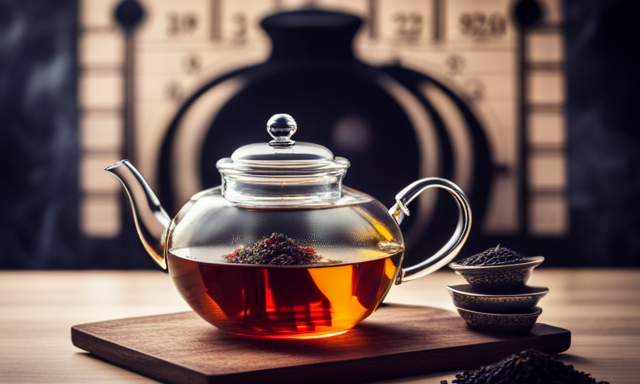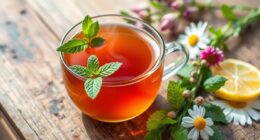As I take a sip of oolong tea, I can’t help but wonder about its acidity level. Is it high or low? Does it have any health implications? These questions have piqued my curiosity, leading me to delve into the world of oolong tea’s acidity.
In this article, we will explore the chemistry behind oolong tea’s acidity, compare it to other popular beverages, and discuss the potential effects on our health. Additionally, we will provide tips on reducing acidity in oolong tea and examine the different varieties and their acidity levels.
It’s important to dispel any misconceptions surrounding oolong tea’s acidity and understand how it may vary depending on our personal sensitivity. So, let’s embark on this journey together, gathering evidence-based knowledge to better appreciate and enjoy oolong tea in moderation.
Key Takeaways
- Oolong tea is not as acidic as lemon juice and does not cause acid reflux or erode tooth enamel.
- Different varieties of oolong tea have varying acidity levels, with longer steeping times and higher temperatures resulting in more acidity.
- Oolong tea offers health benefits for digestion, weight management, and reducing the risk of type 2 diabetes.
- Personal sensitivity to oolong tea’s acidity can vary, so it is important to pay attention to any symptoms or discomfort and consult a healthcare professional for personalized guidance.
Understanding Acidity Levels in Beverages
Oolong tea falls on the spectrum of acidity, with its flavor profile ranging from mildly tangy to subtly tart. The impact of acidity on flavor is significant, as it can enhance or detract from the overall taste experience.
The role of pH in determining acidity levels is crucial to understand this relationship. pH measures the concentration of hydrogen ions in a solution, and the lower the pH value, the higher the acidity. Oolong tea typically has a pH range of 6-7, indicating a slightly acidic nature.
This acidity contributes to the tea’s characteristic tanginess and adds depth to its flavor profile. Understanding the chemistry behind oolong tea’s acidity provides insights into the complex interplay of compounds and flavors.
The Chemistry Behind Oolong Tea’s Acidity
When brewing it, you may notice a tangy flavor that can be attributed to the chemical composition of this unique beverage. Oolong tea’s acidity is determined by the presence of polyphenols, specifically catechins and tannins. These compounds undergo chemical reactions during brewing, resulting in the tangy taste.
In chemistry experiments, researchers have found that oolong tea has a pH level between 6 and 7, making it mildly acidic. This acidity contributes to the overall taste profile of the tea and enhances its flavor.
Additionally, oolong tea’s acidity is linked to its health benefits. The catechins in oolong tea have antioxidant properties that can help reduce the risk of chronic diseases.
Transitioning to the subsequent section about comparing oolong tea’s acidity to other popular beverages, it is important to understand how these acids can vary across different drinks.
Comparing Oolong Tea’s Acidity to Other Popular Beverages
When comparing the acidity of oolong tea to other popular beverages, such as coffee and green tea, it is important to consider the differences in their chemical compositions.
Coffee, for instance, contains high levels of chlorogenic acid, which contributes to its acidic taste.
On the other hand, oolong tea contains polyphenols, which are known to have a slightly lower acidity compared to coffee.
Similarly, green tea also contains polyphenols, but in different concentrations, resulting in a different level of acidity compared to oolong tea.
Coffee vs. Oolong Tea
Although oolong tea is often compared to coffee, it doesn’t give you the jitters like a strong cup of Joe. In fact, oolong tea has a much lower caffeine content compared to coffee, making it a great alternative for those seeking a milder pick-me-up. To better understand the differences between coffee and oolong tea, let’s take a look at the table below:
| Caffeine Content (mg) | Antioxidants | Health Benefits | |
|---|---|---|---|
| Coffee | 95-200 | Few | May boost energy and concentration, but excessive consumption can lead to jitters |
| Oolong | 37-55 | High | Promotes metabolism, aids digestion, strengthens the immune system |
As you can see, while coffee provides a higher caffeine kick, oolong tea offers a wealth of health benefits due to its high antioxidant content. This makes oolong tea a healthier choice over coffee for those looking to improve their overall well-being. Moving on to the next section, let’s explore the benefits of green tea compared to oolong tea.
Green Tea vs. Oolong Tea
In comparison to green tea, oolong tea offers a unique flavor profile that appeals to those seeking a more robust and complex taste experience. While both green tea and oolong tea are derived from the Camellia sinensis plant, they undergo different processing methods which contribute to their distinct characteristics.
Green tea is minimally processed, preserving its natural antioxidants and catechins that provide numerous health benefits. On the other hand, oolong tea is partially fermented, resulting in a more oxidized tea with a deeper flavor profile. This process also imparts oolong tea with a slightly lower acidity compared to green tea.
The potential effects of oolong tea’s acidity on health will be further explored in the subsequent section, highlighting its impact on various aspects of well-being.
Potential Effects of Oolong Tea’s Acidity on Health
When it comes to dental health, the acidity of oolong tea can potentially have negative effects on our enamel. High levels of acidity can lead to enamel erosion, which can weaken our teeth over time.
Additionally, oolong tea’s acidity may also affect the digestive system, particularly in individuals who suffer from acid reflux. The high acidity of oolong tea can exacerbate symptoms and contribute to discomfort in these individuals.
Dental Health and Enamel Erosion
To protect your teeth from enamel erosion, be mindful of how acidic oolong tea is, as it can be as corrosive as battery acid. Dental erosion, caused by the acidity in beverages, can lead to tooth decay and other oral health problems. Oolong tea, with its acidic nature, poses a risk to dental health if consumed excessively or without proper oral hygiene practices. The table below illustrates the pH levels of various substances, highlighting the acidity of oolong tea in comparison to battery acid and other common drinks:
| Substance | pH Level |
|---|---|
| Battery Acid | 0.0 |
| Lemon Juice | 2.0 |
| Oolong Tea | 4.5-5.5 |
| Milk | 6.5 |
| Water | 7.0 |
| Baking Soda | 9.0 |
| Household Ammonia | 11.5 |
Understanding the acidity of oolong tea can help individuals make informed decisions about their dental health. Moving forward, it is important to consider the impact of oolong tea on the digestive system and acid reflux.
Digestive System and Acid Reflux
Take care of your digestive system and be mindful of any acid reflux issues that may arise. Acid reflux prevention is crucial to maintaining good gut health.
When it comes to oolong tea, it is important to be aware of its acidity level and how it can potentially affect your digestive system. Oolong tea is mildly acidic, which means it can trigger acid reflux symptoms in some individuals. However, it is worth noting that the degree of acidity can vary depending on the specific type and preparation of oolong tea.
To reduce acidity in oolong tea, there are several tips you can follow. Transitioning into the subsequent section, it is important to understand how to make oolong tea less acidic to minimize its impact on your digestive system.
Tips for Reducing Acidity in Oolong Tea
If you want to reduce the acidity in your oolong tea, try adding a small amount of milk. Adding a splash of milk can neutralize the acidity and create a smoother taste. Studies show that milk can lower the pH level of oolong tea, making it less acidic. This is especially helpful for individuals with symptoms of acidity, such as heartburn or acid reflux.
Opting for high-quality oolong tea brands that have a lower acidity level can also reduce acidity symptoms. By considering these tips, you can enjoy a less acidic oolong tea experience.
Transitioning to the subsequent section about the benefits of oolong tea beyond acidity, it is important to note that oolong tea offers numerous health advantages beyond its impact on acidity levels.
The Benefits of Oolong Tea Beyond Acidity
Discover the amazing health perks that go beyond acidity when you savor a cup of oolong tea!
-
Oolong tea promotes digestive health by aiding in the breakdown of fats and proteins, reducing the risk of indigestion and bloating.
-
It supports weight management by boosting metabolism and increasing fat oxidation, helping to burn calories more efficiently.
-
Oolong tea contains polyphenols that have been shown to improve insulin sensitivity, potentially reducing the risk of developing type 2 diabetes.
-
It is rich in antioxidants, including catechins and theaflavins, which help protect cells from damage caused by free radicals.
-
Oolong tea has been found to have antibacterial properties, potentially helping to prevent infections in the digestive system.
Transitioning into the subsequent section about different varieties of oolong tea and their acidity levels, it is important to understand the potential health benefits of oolong tea before delving into its acidity levels.
Different Varieties of Oolong Tea and Their Acidity Levels
Immerse yourself in a world of diverse flavors and acidity levels as you explore the various varieties of oolong tea. Each variety offers a unique and delightful sensory experience.
From the floral and fruity notes of Bai Hao Oolong to the roasted and nutty undertones of Da Hong Pao, there is a flavor profile to suit every palate.
The brewing techniques also play a crucial role in the acidity levels of oolong tea. Longer steeping times and higher water temperatures tend to result in a more acidic brew, while shorter steeping times and lower temperatures produce a milder acidity.
By experimenting with different oolong tea flavors and adjusting brewing techniques, you can tailor the acidity levels to your preference.
Transitioning into the subsequent section about common misconceptions about oolong tea’s acidity, let’s debunk the notion that all oolong teas are highly acidic.
Common Misconceptions About Oolong Tea’s Acidity
Indulge yourself in the realm of oolong tea by debunking common misconceptions about its acidity levels. Contrary to popular belief, oolong tea is not highly acidic. In fact, it falls in the middle range of the pH scale, making it less acidic than coffee or black tea. Let’s explore three common misconceptions about oolong tea’s acidity:
-
Oolong tea is as acidic as lemon juice: This is a misconception because lemon juice has a pH of around 2, while oolong tea typically has a pH between 6 and 7.
-
Oolong tea causes acid reflux: There is no scientific evidence to support this claim. In fact, oolong tea has been shown to have potential health benefits, such as improving digestion and reducing inflammation.
-
Oolong tea erodes tooth enamel: While oolong tea contains tannins that can stain teeth, it does not erode tooth enamel like highly acidic beverages.
Understanding these common misconceptions can help you appreciate the health benefits of oolong tea. Now, let’s delve into oolong tea and personal sensitivity to acidity.
Oolong Tea and Personal Sensitivity to Acidity
When it comes to personal sensitivity to acidity in oolong tea, it is important to listen to your body’s reactions. Pay attention to any symptoms or discomfort you may experience after consuming oolong tea, such as heartburn or stomach pain.
If you are unsure about the impact of oolong tea on your health, it is always advisable to consult with a healthcare professional who can provide personalized guidance and advice based on your specific needs and medical history.
Listening to Your Body’s Reactions
Pay attention to how your body reacts to oolong tea, as it may vary from person to person. For example, if you experience stomach discomfort or acid reflux after drinking oolong tea, it could be a sign that it is too acidic for your body. Being mindful of your body’s signals is crucial for ensuring a pleasant tea-drinking experience. To help you understand how your body responds to oolong tea, consider keeping a record of your symptoms and the specific tea you consumed. This can be done using a simple table, like the one below:
| Symptoms | Oolong Tea Brand A | Oolong Tea Brand B | Oolong Tea Brand C |
|---|---|---|---|
| Stomach Discomfort | Yes | No | Yes |
| Acid Reflux | No | Yes | No |
| Other | No | No | Yes |
Analyzing this data can provide insights into which brands or types of oolong tea are more suitable for your body. If you consistently experience negative reactions, it may be necessary to consult with a healthcare professional to further evaluate your sensitivity to oolong tea’s acidity.
Consulting with a Healthcare Professional
Consider seeking guidance from a healthcare professional to ensure your well-being and address any concerns you may have regarding your body’s reaction to oolong tea. A healthcare professional can provide valuable insights into the health risks and potential benefits associated with consuming oolong tea. Here are four reasons why consulting with a healthcare professional is important:
-
Personalized advice: A healthcare professional can assess your individual health status and provide tailored recommendations based on your specific needs.
-
Monitoring potential side effects: They can help monitor any adverse reactions or side effects you may experience, ensuring your safety and well-being.
-
Managing existing conditions: If you have any pre-existing health conditions, a healthcare professional can advise on how oolong tea may interact with your condition and medications.
-
Evidence-based information: Healthcare professionals rely on scientific evidence to inform their recommendations, providing you with accurate and reliable information.
With guidance from a healthcare professional, you can make informed decisions about consuming oolong tea and enjoy its potential benefits while minimizing any potential health risks.
Conclusion: Enjoying Oolong Tea in Moderation
To fully savor the delightful flavors of oolong tea, make sure to indulge in moderation. While oolong tea offers numerous health benefits, excessive consumption may have adverse effects on dental health and the digestive system. It is important to note that oolong tea contains tannins, which can potentially stain teeth and contribute to dental erosion. Additionally, the caffeine content in oolong tea can stimulate gastric acid secretion, leading to digestive discomfort in sensitive individuals. To maintain good dental health and promote a healthy digestive system, it is recommended to limit oolong tea intake and practice good oral hygiene. Consult with a healthcare professional for personalized advice and recommendations. Enjoy the rich flavors of oolong tea, but remember to do so in moderation.
| Dental Health | Digestive System |
|---|---|
| Potential teeth staining and erosion due to tannins | Gastric acid secretion stimulated by caffeine |
| Practice good oral hygiene | Limit intake for individuals with sensitive digestion |
| Consult a dentist for personalized advice | Seek healthcare professional’s guidance for dietary adjustments |
Frequently Asked Questions
Can oolong tea’s acidity levels vary depending on how it is brewed?
Yes, the acidity levels of oolong tea can vary depending on how it is brewed. The brewing time and temperature can affect the extraction of certain compounds, potentially influencing its potential health benefits and effects on digestion.
What are the potential long-term health effects of regularly consuming oolong tea with high acidity?
Regularly consuming oolong tea with high acidity can potentially lead to health risks. The acidity can affect digestion, causing issues like acid reflux and stomach discomfort. It is important to be mindful of the acidity levels when consuming oolong tea.
How does the acidity of oolong tea compare to that of fruit juices?
Compared to fruit juices, oolong tea has a moderate acidity level. When comparing acidity, oolong tea is less acidic than coffee. The impact of oolong tea’s acidity on digestion is still being researched.
Are there any natural remedies or additives that can reduce the acidity of oolong tea?
Natural remedies and additives can be used to reduce the acidity of oolong tea. These options include adding alkaline substances like baking soda or using natural sweeteners like honey to balance the acidity levels.
Is there any scientific evidence to support the claim that oolong tea’s acidity can affect tooth enamel?
Scientific evidence supports the claim that oolong tea’s acidity can harm tooth enamel. Studies show that oolong tea, with varying pH levels when brewed differently, can contribute to enamel erosion, leading to dental issues.
Conclusion
In conclusion, after thoroughly examining the acidity levels of oolong tea, it is evident that moderation is key.
While oolong tea does possess a certain level of acidity, it is important to note that this can vary depending on the variety.
By understanding the chemistry behind oolong tea’s acidity and implementing tips to reduce acidity, individuals can still enjoy this beverage without any adverse effects on their health.
So, let’s savor the balanced flavors of oolong tea in a mindful and measured manner, appreciating its unique characteristics while maintaining our well-being.










